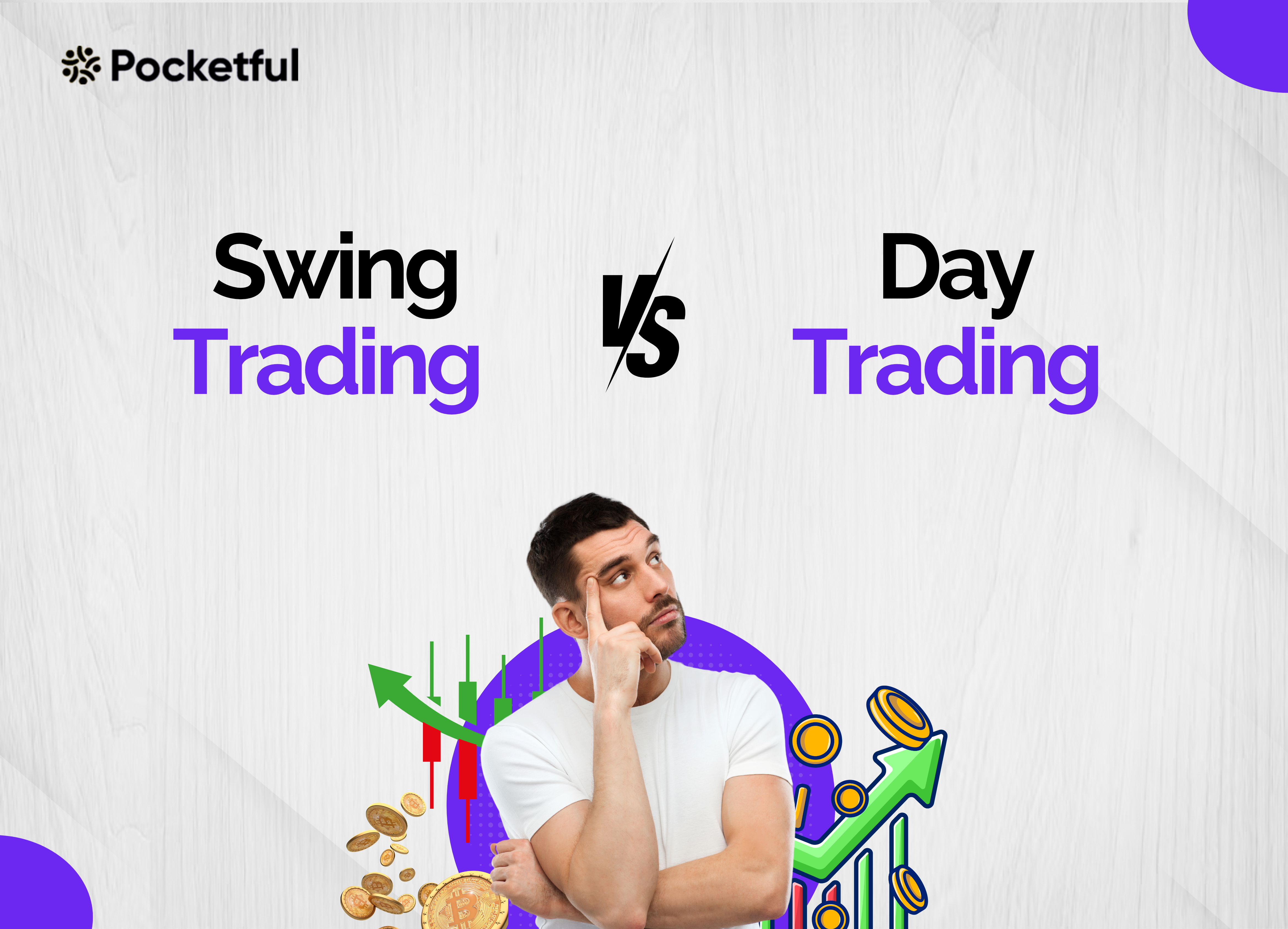| Type | Description | Contributor | Date |
|---|---|---|---|
| Post created | Pocketful Team | Jun-07-24 | |
| Add new links | Nisha | Mar-18-25 |
Swing Trading vs Day Trading: Which Strategy Is Right For You?

A million-dollar question: which trading strategy is right for you: Swing Trading or Day Trading? Let’s find out the answer.
What is Day Trading?
The Day trading involves buying and selling of financial instruments like stocks, bonds, futures, commodities, and currencies to generate profit from the short price movement within a single trading day. Many positions can be entered, which can last from several minutes to a few hours during the single trading day.
Traders essentially close the position before the day ends to avoid risk exposure. As the activity of buying and selling takes place within a single day, traders make fast decisions on market direction and usually exit once the trade goes against their view.
Anyone can perform day trading, but it requires lots of time and effort to monitor positions and some technical setup and knowledge to decide when to exit the market. A day trader wants to keep the risk minimum by not carrying it overnight. This is one of the major reasons for holding positions only until the end of the day because they are not subjected to overnight changes.
There are multiple techniques which traders deploy in Day Trading. Some day trading techniques include:
- Scalping: It Involves buying and selling a stock multiple times in a day to make small profits from small price movements. The time period for holding a trade could be a couple of seconds to minutes.
- Range trading: It Involves buying when an asset’s price is in a particular range, it could be near the low end of the price range and selling when it’s near the high end of price range.
- Algo Trading or High-frequency trading (HFT): It uses a computer-based system to automatically track price changes and execute trades. It is also called Algo trading.
- Momentum trading: It means entering into a position of buying and selling on the basis of recent primary trends and exiting as soon as it shows signs of reversal. Momentum traders tend and volatility.
What is Swing Trading?

It involves buying and selling a financial instruments such as stocks, bonds, currencies, and commodities in an attempt to exploit short to mid-term price movements in a security using a favorable risk-reward ratio. The time period for holding a trade could be several days to weeks.
Swing trading is often considered better for beginners compared to scalp trading or day trading. It requires fewer orders compared to scalp trading, hence lower trading costs. Also, it doesn’t require continuous monitoring. Though the minimum return is not guaranteed in this, Swing traders still have the potential to make a similar profit as of a scalper with less trading activity and less risk.
Swing traders use many technical analysis signals to enter and exit a trade, such as Fibonacci retracement, Channel trading, MACD, RSI Crossover, divergences, and moving averages. Moreover, they also use Fundamental triggers like Quarterly results, management insights, inflation, interest rate scenarios, etc.
What is the difference between Day Trading Vs Swing Trading
| Day Trading | Swing Trading |
|---|---|
| There is a low margin requirement for the Day trading as traders close the position on the same day. | The requirement of margin is high compared to day trading. |
| The higher leverage is made available for Intraday trading. | The lower leverage is available for swing traders as it involves holding a position for days. |
| Day traders are known as full-time traders as more time is required to execute and monitor the trades. | Swing traders are known as part time traders as less time is required to monitor the trades. |
| They make multiple trades and keep on exiting with small profits and losses. | Swing traders analyze trends and choose securities that will perform better in future to earn profits. |
Read Also: 5 Must-Read Best Swing Trading Books for Trader
Quick Summarization

- Swing trading requires less involvement than day trading as it requires less monitoring.
- Swing trade positions are subject to overnight market risks, as swing trading often involves at least an overnight hold, whereas day traders close out positions before the market closes.
- Day traders have more access to margin or leverage as compared to Swing traders. Hence in day trading, because of leverage, traders risk magnifies but the good thing is if market goes against their view, they have time to instantly cut the position.
- Swing traders may incorporate both technical and fundamental analysis, whereas a day trader is more likely to focus on using technical analysis.
Read Also: What is the Best Time Frame for Swing Trading?
Conclusion
In summation, there are no right or wrong answers to which trading strategy is right for you. It depends upon your skills, style, preference, and availability of time.
Most of the people think trading is different from their actual mentality. Technical analysis, which is one of the tools used to gauge market direction, is nothing but a tool for judging mass psychology. The more the traders anticipate that the market is still undervalued or a certain sector or stock is available at a good valuation, the more they will buy, and the market will start taking support and eventually bounce. In similar way, the more the traders perceive that the market is overvalued or certain group of stocks or sectors are expensive, the more they will start exiting their position or start shorting.
If traders could think they can analyze the market better, and are able to take risks to bet on market direction, then it is suggested that they go for Swing Trading. There are pros and cons of both the trading styles, so after taking them into consideration and as per one’s risk appetite, one can choose their respective trading style, Swing or Day Trading.
Frequently Asked Questions (FAQs)
What is Day Trading?
Day trading is the activity of buying and selling financial instruments like stocks, bonds, futures, or commodities to generate profit from the price movement within a single trading day.
What is Swing Trading?
Swing trading is the activity of buying and selling financial instruments like stocks, bonds, futures, or commodities to generate profit from the price movement where traders keep the position open for a few days to a few weeks.
Do Swing Traders make multiple trades?
No, it is Day traders who make multiple trades and keep on exiting with small profits and losses.
Which trading Strategy is less risky?
Day trading is less risky than the Swing Trading as a trader can close the position on the same day, and there are no overnight uncertainty risks.
What is the major difference between Day Trading and Swing Trading?
There are various differences in Day trading and Swing trading such as difference of risks, time period, costs, size of profits and losses, etc.
Disclaimer
The securities, funds, and strategies discussed in this blog are provided for informational purposes only. They do not represent endorsements or recommendations. Investors should conduct their own research and seek professional advice before making any investment decisions.